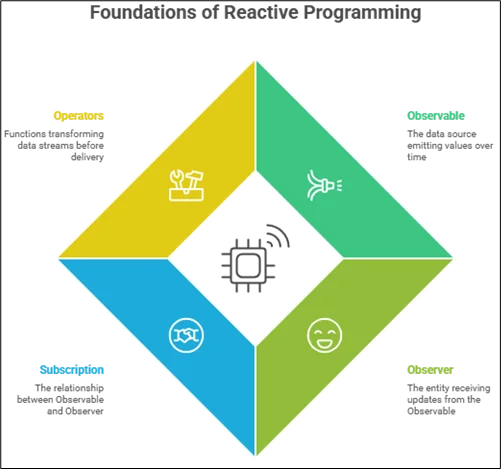|
Voiced by Amazon Polly |
Introduction
In the evolving landscape of software development, the need for systems that handle asynchronous data streams efficiently has led to the rise of reactive programming. At its core, reactive programming offers a paradigm shift, from writing code that controls data flow step by step to composing systems that react to data changes dynamically. The Observable design pattern is a fundamental building block in this paradigm. It enables components to observe data changes, propagate updates, and respond to them automatically, thereby creating a seamless flow of asynchronous and event-driven operations.
This blog explores the concept of reactive programming, the mechanics of the Observable design pattern, and how they intersect to create responsive, scalable, and maintainable systems, all without diving into real-life examples.
Pioneers in Cloud Consulting & Migration Services
- Reduced infrastructural costs
- Accelerated application deployment
Reactive Programming
Reactive programming is a declarative programming paradigm centered around data streams and the propagation of change. Instead of explicitly managing control flow and state transitions, a reactive system defines how data transformations occur and how components should respond when data changes.
In simpler terms, reactive programming treats everything as a stream of events. These streams can emit values over time, and components can subscribe to them to receive updates. Whenever a change occurs, it automatically triggers updates downstream, ensuring that all dependent components remain synchronized.
Key characteristics of reactive programming include:
- Asynchronous Data Flow: Data is processed as it arrives, allowing systems to handle multiple events concurrently without blocking.
- Event-driven Architecture: Logic executes in response to events rather than being triggered by sequential commands.
- Declarative Style: Focus shifts from how to perform tasks to what relationships and transformations exist between data entities.
- Backpressure Management: Systems control the flow of data to prevent overwhelming subscribers with excessive event notifications.
Reactive programming is often implemented using Reactive Extensions (Rx) or similar libraries that provide a consistent model for working with asynchronous streams.
The Observable Design Pattern
At the heart of reactive programming lies the Observable design pattern. This pattern establishes a one-to-many dependency between objects so that when one object (the Observable) changes state, all its dependents (the Observers) are automatically notified.
Core Concepts
- Observable (Subject): The Observable is a data source that can emit a sequence of values over time. These values can represent data, signals, or notifications. Observables manage a list of observers and provide mechanisms for subscribing or unsubscribing.
- Observer (Subscriber): Observers are entities that express interest in an Observable’s data stream. When subscribed, they receive updates whenever new data is emitted, an error occurs, or the stream completes.
- Subscription: A subscription represents the relationship between an Observable and an Observer. It can be terminated to stop receiving further updates.
- Operators: Operators are functions used to transform, filter, or combine data streams before they reach subscribers. They enable the manipulation of asynchronous data declaratively.

Workflow
- An Observable produces data over time.
- One or more Observers subscribe to the Observable.
- The Observable emits data through the stream.
- Each Observer reacts to the data according to the defined logic.
- The stream completes or errors out, signaling the end of emission or an issue in processing.
The Observable pattern enforces decoupling between data producers and consumers, enabling modular, testable, and reusable code structures.
Connecting Reactive Programming and the Observable Pattern
Reactive programming leverages the Observable design pattern as its foundational mechanism for handling data streams. In this paradigm, Observables represent data flows, while Observers define reactions to emitted events. By chaining operators and composing Observables, developers can create complex data pipelines with clear, declarative semantics.
Here’s how the Observable pattern strengthens reactive programming:
- Asynchronous Event Handling: Observables emit data asynchronously, allowing systems to process information without blocking threads or waiting for completion.
- Data Stream Composition: Reactive programming provides operators such as map, filter, merge, and combineLatest, which can be chained to build complex event transformations. These operators operate on Observables, enhancing modularity and readability.
- Error and Completion Handling: Observables inherently support structured error handling and completion notifications, ensuring predictable stream termination and resilience against runtime failures.
- State Propagation: Since Observables notify observers automatically upon changes, reactive systems maintain consistent states without manual intervention.
Thus, the Observable pattern serves as both a conceptual foundation and a technical implementation for reactive programming frameworks.
Benefits of Reactive Programming with Observables
- Improved Responsiveness: Reactive systems respond immediately to changes in input, thereby enhancing overall responsiveness.
- Simplified Asynchronous Logic: By abstracting away callback management, reactive programming simplifies handling of asynchronous data sources.
- High Composability: Observables can be combined and transformed using operators, promoting a declarative and composable coding style.
- Resilience and Scalability: Reactive systems adapt gracefully to varying workloads, making them more resilient under pressure.
- Enhanced Readability and Maintainability: The separation between data producers and consumers makes the architecture cleaner and easier to understand.
Challenges and Considerations
While reactive programming with Observables provides numerous advantages, it also introduces certain challenges that must be addressed:
- Learning Curve: The reactive paradigm differs significantly from imperative programming, requiring a shift in mindset.
- Debugging Complexity: Tracing data flow across asynchronous streams can be more challenging than traditional procedural flows.
- Overhead of Abstraction: The extensive use of streams and operators can introduce performance overhead if not implemented carefully.
- Memory Management: Improperly unsubscribed Observables can lead to memory leaks, underscoring the importance of disciplined resource handling.
Understanding these trade-offs ensures that developers adopt reactive programming effectively while maintaining code efficiency and stability.
Reactive Streams and Backpressure
One of the crucial aspects of reactive programming is backpressure management. Backpressure occurs when the data producer emits events faster than the consumer can process them. Without proper handling, this can lead to performance degradation or memory exhaustion.
Reactive streams introduce mechanisms to regulate this flow, allowing observers to signal demand to observables. This ensures that data production aligns with processing capacity, maintaining system stability under varying loads.
Conclusion
Reactive programming, driven by the Observable design pattern, represents a paradigm shift in how software systems handle asynchronous and event-driven data. By emphasizing responsiveness, composability, and declarative data transformation, it empowers developers to build systems that are both efficient and maintainable. The Observable pattern acts as the backbone of this model, providing a clear contract between data producers and consumers while facilitating real-time responsiveness.
Drop a query if you have any questions regarding Reactive programming and we will get back to you quickly.
Empowering organizations to become ‘data driven’ enterprises with our Cloud experts.
- Reduced infrastructure costs
- Timely data-driven decisions
About CloudThat
CloudThat is an award-winning company and the first in India to offer cloud training and consulting services worldwide. As a Microsoft Solutions Partner, AWS Advanced Tier Training Partner, and Google Cloud Platform Partner, CloudThat has empowered over 850,000 professionals through 600+ cloud certifications winning global recognition for its training excellence including 20 MCT Trainers in Microsoft’s Global Top 100 and an impressive 12 awards in the last 8 years. CloudThat specializes in Cloud Migration, Data Platforms, DevOps, IoT, and cutting-edge technologies like Gen AI & AI/ML. It has delivered over 500 consulting projects for 250+ organizations in 30+ countries as it continues to empower professionals and enterprises to thrive in the digital-first world.
FAQs
1. What is the difference between an Observable and a Promise?
ANS: – A Promise represents a single future value or error, resolved once and then completed. In contrast, an Observable emits multiple values over time and supports operations like cancellation, composition, and transformation. While Promises handle one-time asynchronous operations, Observables manage continuous data streams.
2. Is reactive programming the same as functional programming?
ANS: – No, but they share similarities. Functional programming emphasizes immutability and pure functions, while reactive programming focuses on data streams and event propagation. Reactive programming often incorporates functional principles, such as mapping, filtering, and reducing streams, but applies them in an asynchronous, event-driven context.

WRITTEN BY Hridya Hari
Hridya Hari is a Subject Matter Expert in Data and AIoT at CloudThat. She is a passionate data science enthusiast with expertise in Python, SQL, AWS, and exploratory data analysis.


 Login
Login


 November 11, 2025
November 11, 2025 PREV
PREV










Comments